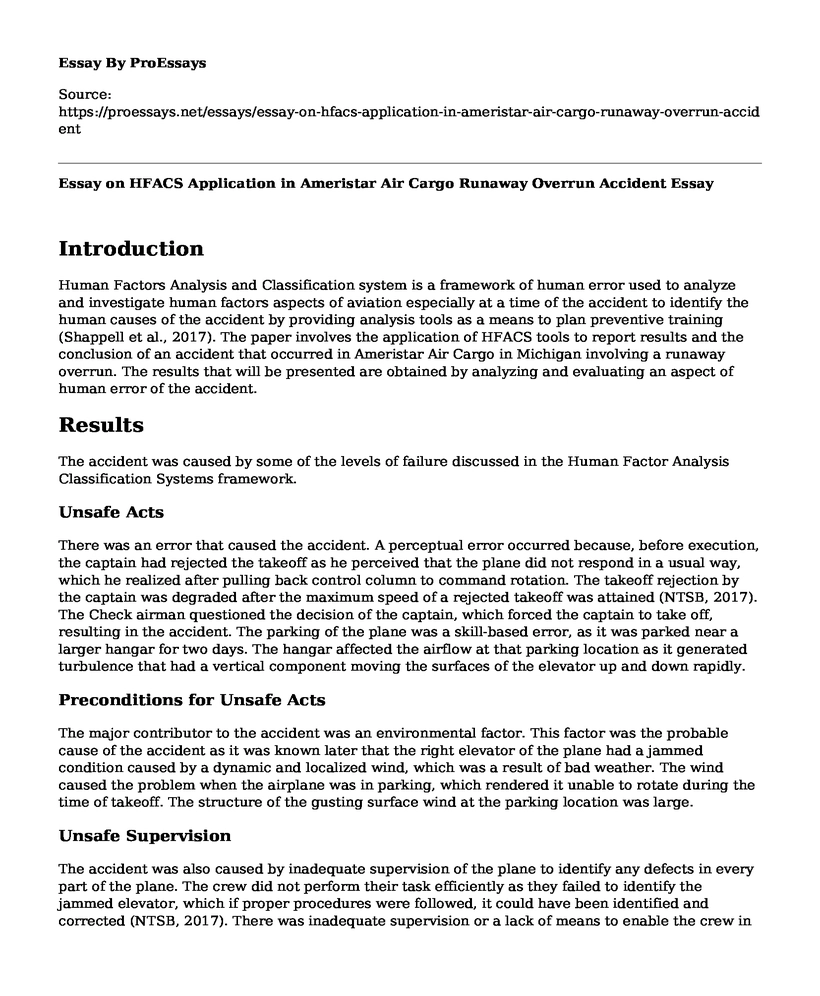Introduction
Human Factors Analysis and Classification system is a framework of human error used to analyze and investigate human factors aspects of aviation especially at a time of the accident to identify the human causes of the accident by providing analysis tools as a means to plan preventive training (Shappell et al., 2017). The paper involves the application of HFACS tools to report results and the conclusion of an accident that occurred in Ameristar Air Cargo in Michigan involving a runaway overrun. The results that will be presented are obtained by analyzing and evaluating an aspect of human error of the accident.
Results
The accident was caused by some of the levels of failure discussed in the Human Factor Analysis Classification Systems framework.
Unsafe Acts
There was an error that caused the accident. A perceptual error occurred because, before execution, the captain had rejected the takeoff as he perceived that the plane did not respond in a usual way, which he realized after pulling back control column to command rotation. The takeoff rejection by the captain was degraded after the maximum speed of a rejected takeoff was attained (NTSB, 2017). The Check airman questioned the decision of the captain, which forced the captain to take off, resulting in the accident. The parking of the plane was a skill-based error, as it was parked near a larger hangar for two days. The hangar affected the airflow at that parking location as it generated turbulence that had a vertical component moving the surfaces of the elevator up and down rapidly.
Preconditions for Unsafe Acts
The major contributor to the accident was an environmental factor. This factor was the probable cause of the accident as it was known later that the right elevator of the plane had a jammed condition caused by a dynamic and localized wind, which was a result of bad weather. The wind caused the problem when the airplane was in parking, which rendered it unable to rotate during the time of takeoff. The structure of the gusting surface wind at the parking location was large.
Unsafe Supervision
The accident was also caused by inadequate supervision of the plane to identify any defects in every part of the plane. The crew did not perform their task efficiently as they failed to identify the jammed elevator, which if proper procedures were followed, it could have been identified and corrected (NTSB, 2017). There was inadequate supervision or a lack of means to enable the crew in the plane to detect the problem of the jammed elevator during the preflight checks. Another error here is the incorrect installation of the valve assembly cable, which resulted in an evacuation slide malfunction of the right door of the plane. The door did not inflate during the evacuation, causing minor injury on one passenger. The inspection team could have identified the problem using valve testing procedures.
Organizational influence
The operational process and climate of the company contributed to the accident through its standard operating procedures. The check airman, who was a pilot monitoring, wanted the pilot to adhere to the procedures of the company and take off after V1 was attained. They did not attempt to intervene in the standards set by the company. In this way, the company influenced the accident; also, the company lacked a proper verification means by inspection team before takeoff. The preflight inspection done lacked proper procedures in the operating manual making it not possible to detect the jam in the elevator and the defect in the front right door of the plane. The company did not have proper procedures for operators to enable them to monitor the wind that can affect airplanes in parking.
Conclusion
In conclusion, the Human Factors Analysis and Classification systems provided the category of the factors that caused the accident. The company can fill the gaps identified by accessing the company climate and process, adopt proper operational procedures, especially in the manuals that are used by the inspection team to check for maintenance and the manual used to inspect the movement of wind in parking locations.
References
NTSB (2017). Runway Overrun During Rejected Takeoff Ameristar Air Cargo, Inc., dba Ameristar Charters, flight 9363 Boeing MD-83, N786TW Ypsilanti, Michigan. AAR1901 accident report. Retrieved from https://www.ntsb.gov/investigations/AccidentReports/Reports/AAR1901.pdf
Shappell, S., Detwiler, C., Holcomb, K., Hackworth, C., Boquet, A., & Wiegmann, D. A. (2017). Human error and commercial aviation accidents: an analysis using the human factors analysis and classification system. Human error in aviation (pp. 73-88). Routledge.
Cite this page
Essay on HFACS Application in Ameristar Air Cargo Runaway Overrun Accident. (2023, Apr 24). Retrieved from https://proessays.net/essays/essay-on-hfacs-application-in-ameristar-air-cargo-runaway-overrun-accident
If you are the original author of this essay and no longer wish to have it published on the ProEssays website, please click below to request its removal:
- Essay Sample on Nursing Interventions with Rationale
- Pros and Cons of Leadership Models and Grids Essay
- Assignment Example on Leadership Traits, Behaviors and Styles
- Comparison Between Clinton Healthcare Legislative and Obama Healthcare Legislative
- Implementation of Changes by Government Paper Example
- Quality Indicators: Nursing & Patient Care Impact - Essay Sample
- Asthma: Causes, Symptoms, and Treatment - Essay Sample







